Abstract
The relationship between DNA double-strand break rejoining rates, inherent radiation sensitivity and tumour response to radiation therapy was determined for a group of 25 squamous cell carcinoma (SCC) and eight sarcoma (SAR) tumours. DNA double-strand break frequencies were measured by neutral filter elution in first passage following explant tumour samples after in vitro exposure to 100 Gy of 60Co gamma-rays. There was no significant difference between SCC and SAR tumour cells in their sensitivity to break induction, but in a 1 h time period SAR tumour cells rejoined significantly fewer breaks than SCC tumour cells, consistent with the greater sensitivity of SAR and suggesting that differences in rates of break rejoining account for the different distributions of radiosensitivities seen when different tumour types are compared. The percentage of breaks rejoined in 1 h in these tumour samples correlated well with D(o) and with the beta component of the survival curve, measured in vitro by clonogenic assay in tumour cell lines established from the tumour samples, but not with SF2 or the alpha component of the survival curve. The rates of DNA double-strand break rejoining therefore appear to influence the exponential portion of survival curves and probably the interactions between breaks. The percentage of breaks rejoined in 1 h was higher in SCC tumours that subsequently failed radiotherapy and, although the differences were not significant, they suggest that rates of break rejoining are an important component of tumour response to radiation therapy.
Full text
PDF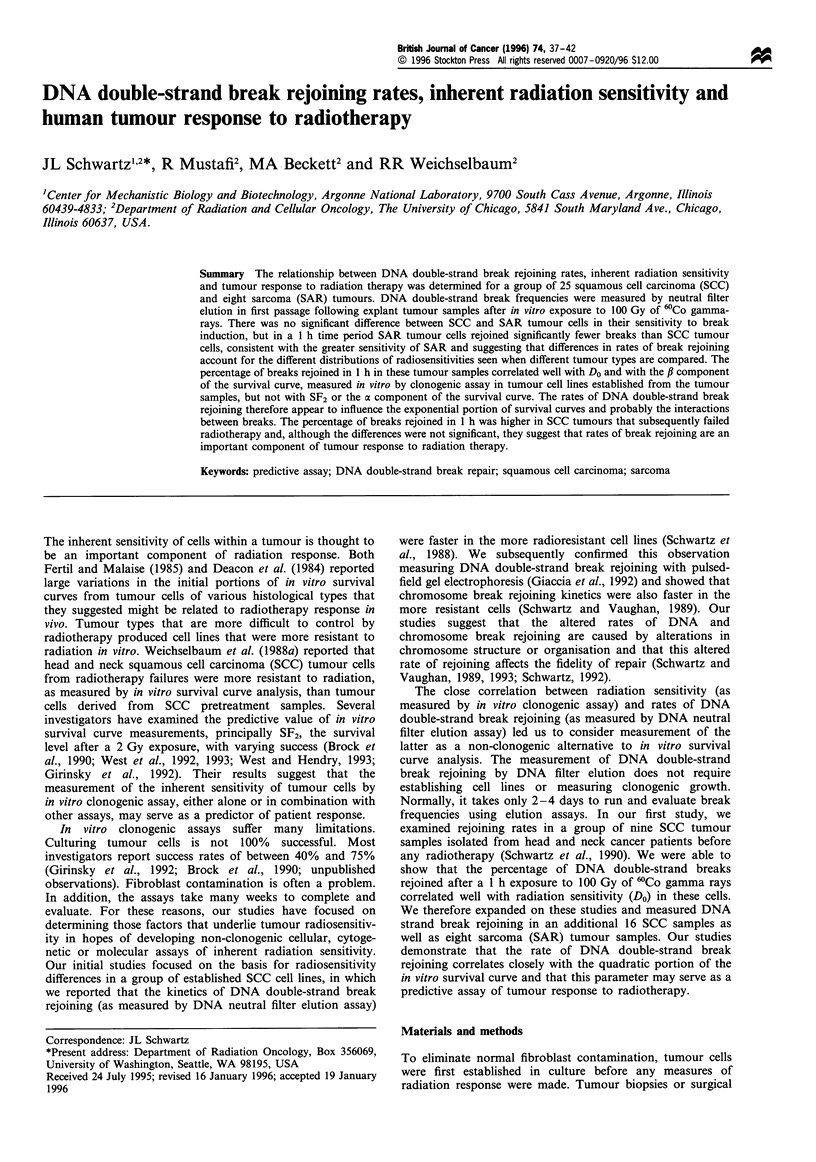
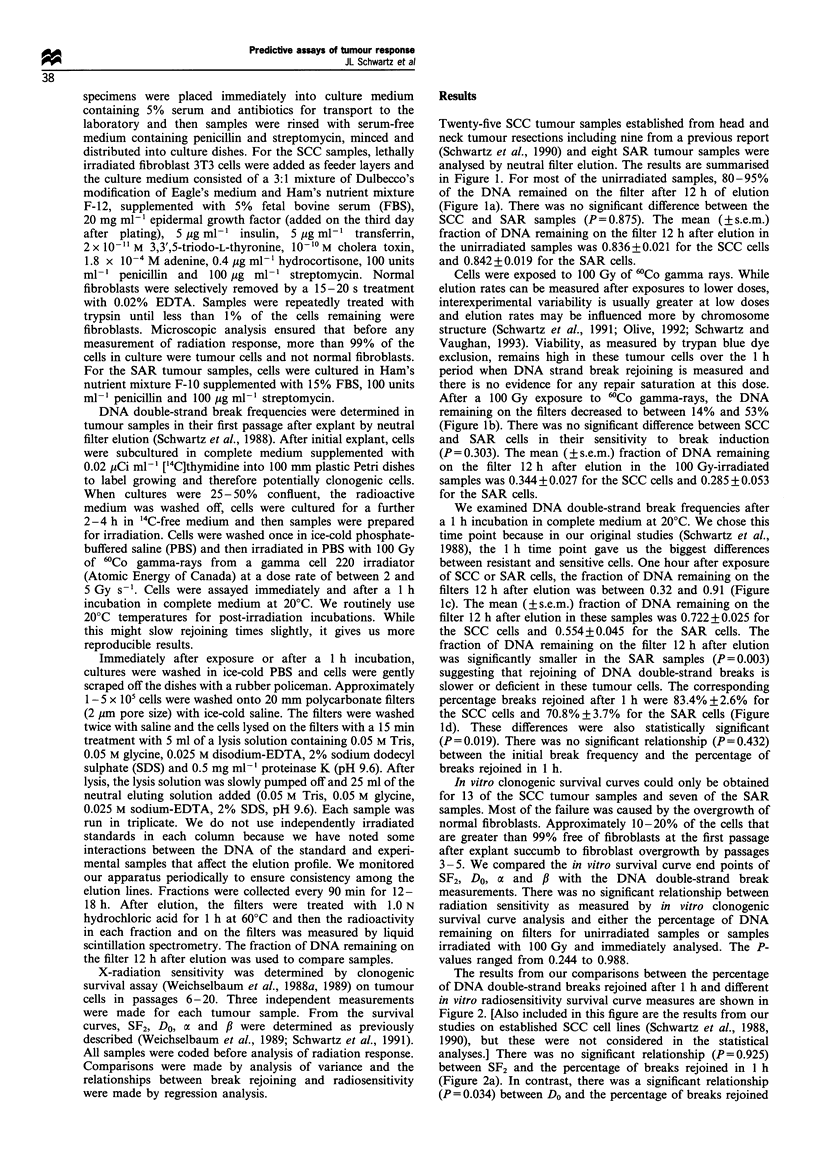
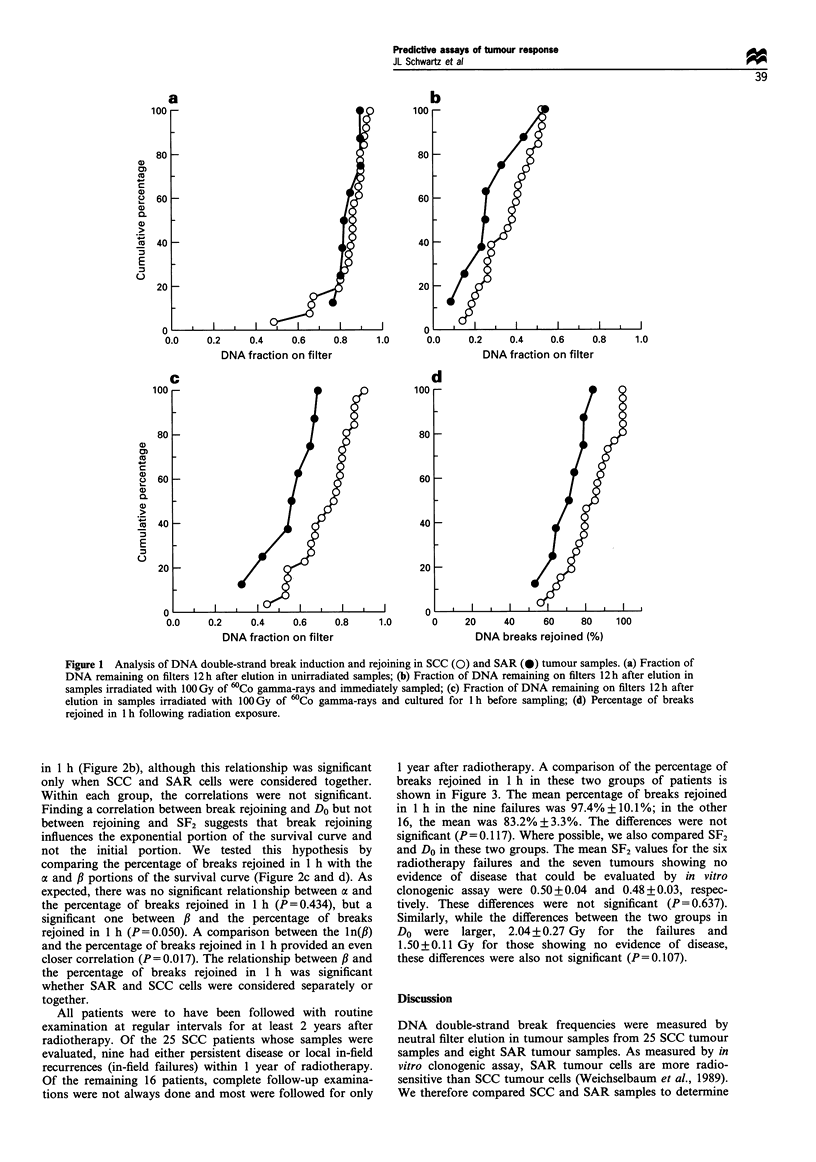
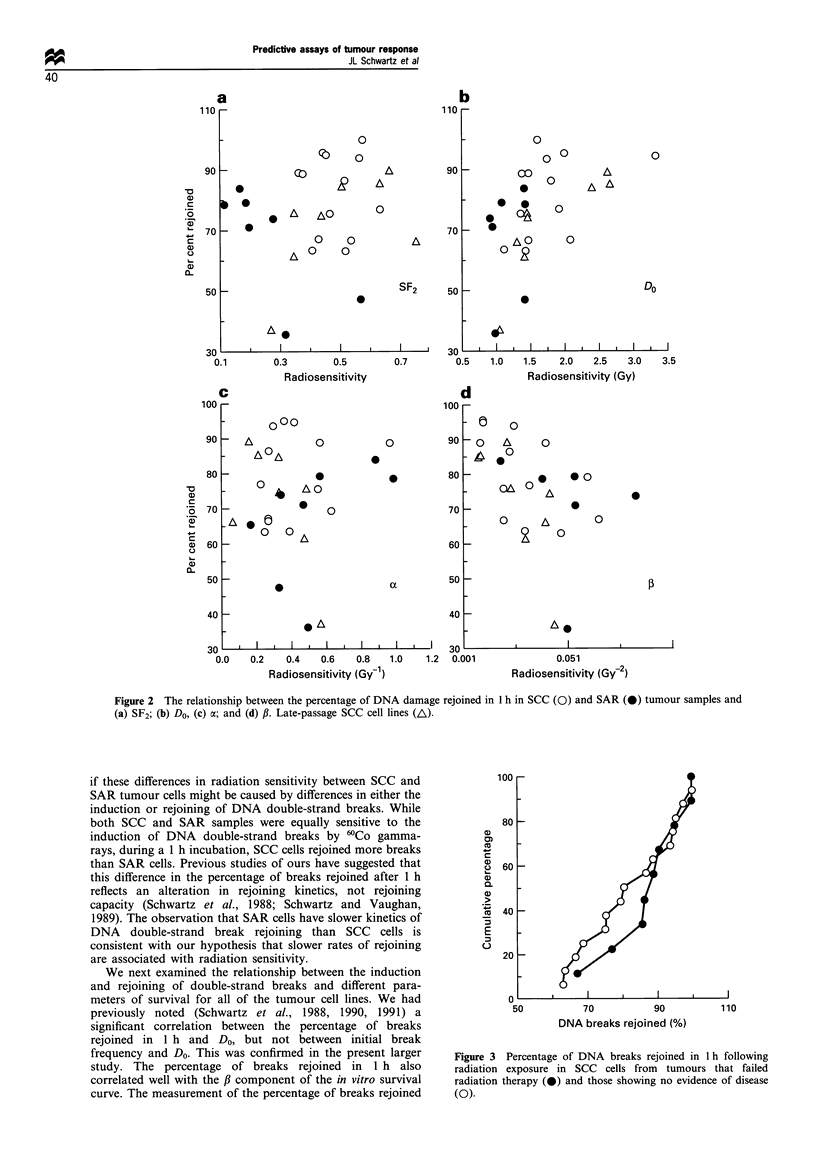
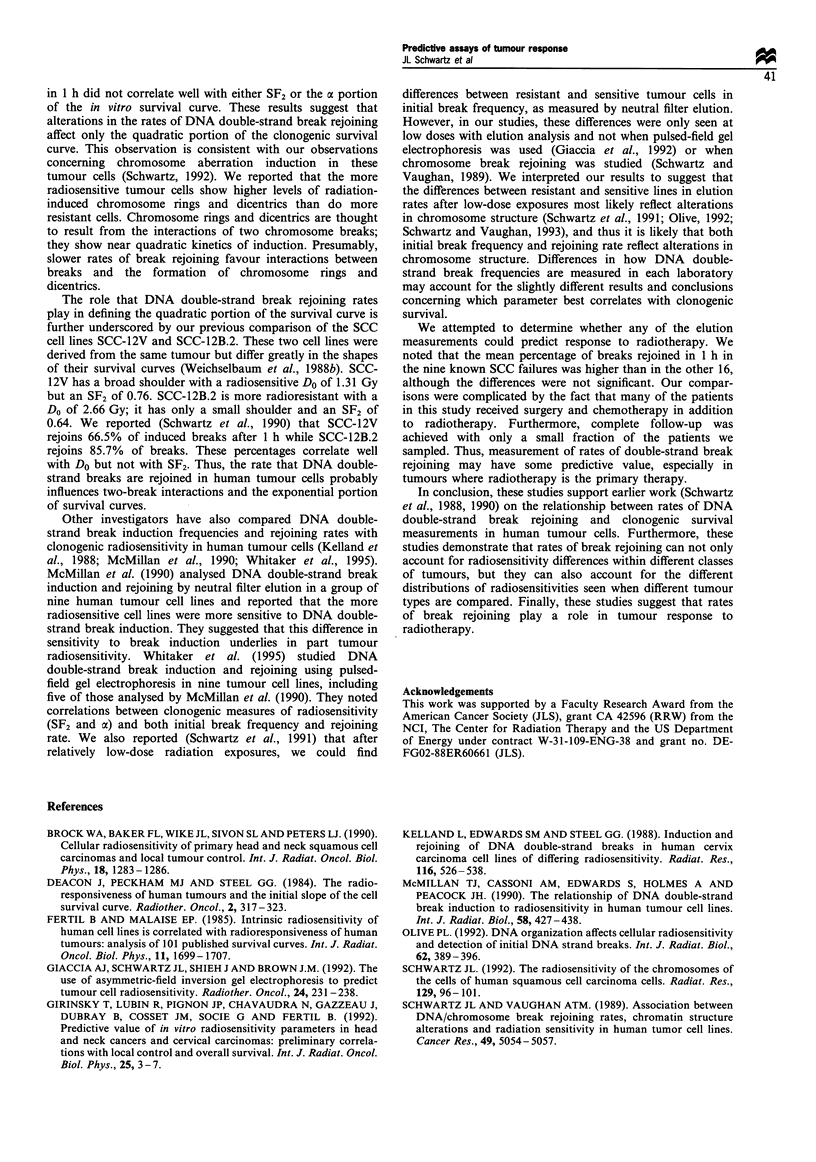
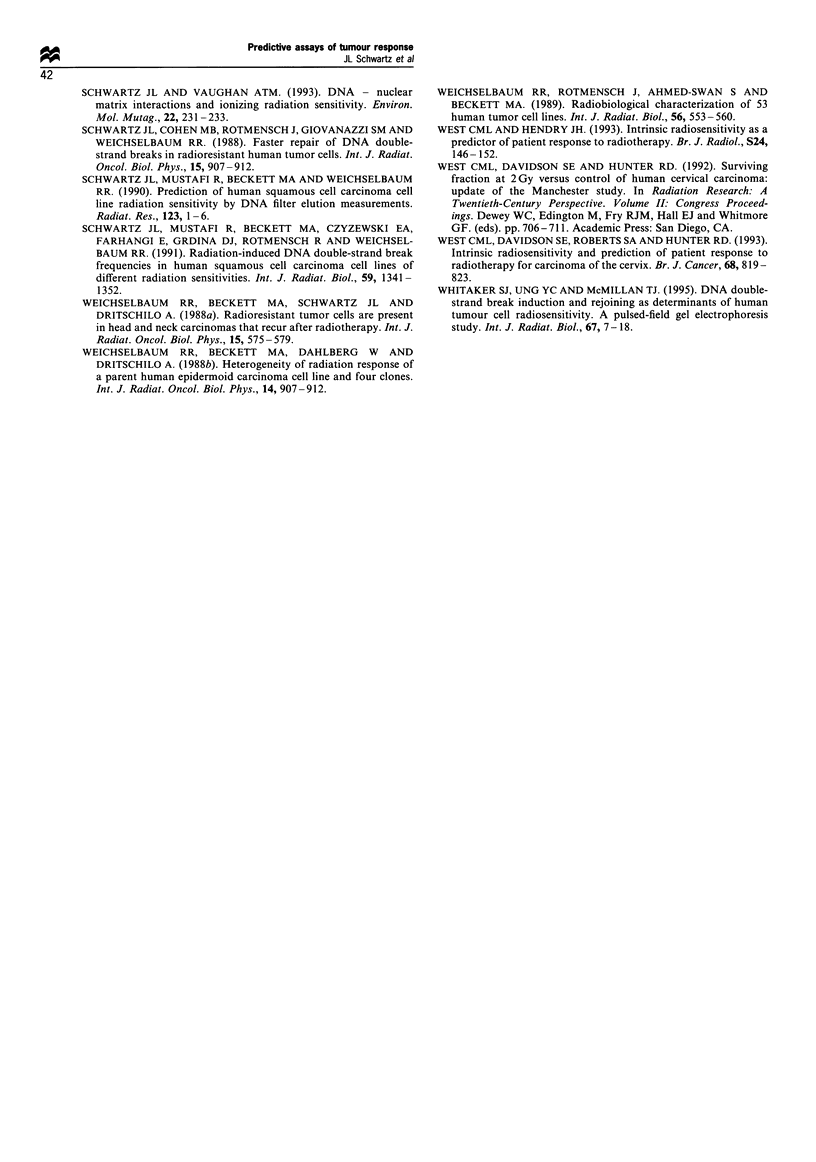
Selected References
These references are in PubMed. This may not be the complete list of references from this article.
- Brock W. A., Baker F. L., Wike J. L., Sivon S. L., Peters L. J. Cellular radiosensitivity of primary head and neck squamous cell carcinomas and local tumor control. Int J Radiat Oncol Biol Phys. 1990 Jun;18(6):1283–1286. doi: 10.1016/0360-3016(90)90298-x. [DOI] [PubMed] [Google Scholar]
- Deacon J., Peckham M. J., Steel G. G. The radioresponsiveness of human tumours and the initial slope of the cell survival curve. Radiother Oncol. 1984 Dec;2(4):317–323. doi: 10.1016/s0167-8140(84)80074-2. [DOI] [PubMed] [Google Scholar]
- Fertil B., Malaise E. P. Intrinsic radiosensitivity of human cell lines is correlated with radioresponsiveness of human tumors: analysis of 101 published survival curves. Int J Radiat Oncol Biol Phys. 1985 Sep;11(9):1699–1707. doi: 10.1016/0360-3016(85)90223-8. [DOI] [PubMed] [Google Scholar]
- Giaccia A. J., Schwartz J., Shieh J., Brown J. M. The use of asymmetric-field inversion gel electrophoresis to predict tumor cell radiosensitivity. Radiother Oncol. 1992 Aug;24(4):231–238. doi: 10.1016/0167-8140(92)90229-n. [DOI] [PubMed] [Google Scholar]
- Kelland L. R., Edwards S. M., Steel G. G. Induction and rejoining of DNA double-strand breaks in human cervix carcinoma cell lines of differing radiosensitivity. Radiat Res. 1988 Dec;116(3):526–538. [PubMed] [Google Scholar]
- McMillan T. J., Cassoni A. M., Edwards S., Holmes A., Peacock J. H. The relationship of DNA double-strand break induction to radiosensitivity in human tumour cell lines. Int J Radiat Biol. 1990 Sep;58(3):427–438. doi: 10.1080/09553009014551781. [DOI] [PubMed] [Google Scholar]
- Olive P. L. DNA organization affects cellular radiosensitivity and detection of initial DNA strand breaks. Int J Radiat Biol. 1992 Oct;62(4):389–396. doi: 10.1080/09553009214552261. [DOI] [PubMed] [Google Scholar]
- Schwartz J. L., Mustafi R., Beckett M. A., Czyzewski E. A., Farhangi E., Grdina D. J., Rotmensch J., Weichselbaum R. R. Radiation-induced DNA double-strand break frequencies in human squamous cell carcinoma cell lines of different radiation sensitivities. Int J Radiat Biol. 1991 Jun;59(6):1341–1352. doi: 10.1080/09553009114551211. [DOI] [PubMed] [Google Scholar]
- Schwartz J. L., Rotmensch J., Giovanazzi S., Cohen M. B., Weichselbaum R. R. Faster repair of DNA double-strand breaks in radioresistant human tumor cells. Int J Radiat Oncol Biol Phys. 1988 Oct;15(4):907–912. doi: 10.1016/0360-3016(88)90125-3. [DOI] [PubMed] [Google Scholar]
- Schwartz J. L. The radiosensitivity of the chromosomes of the cells of human squamous cell carcinoma cell lines. Radiat Res. 1992 Jan;129(1):96–101. [PubMed] [Google Scholar]
- Schwartz J. L., Vaughan A. T. Association among DNA/chromosome break rejoining rates, chromatin structure alterations, and radiation sensitivity in human tumor cell lines. Cancer Res. 1989 Sep 15;49(18):5054–5057. [PubMed] [Google Scholar]
- Schwartz J. L., Vaughan A. T. DNA-nuclear matrix interactions and ionizing radiation sensitivity. Environ Mol Mutagen. 1993;22(4):231–233. doi: 10.1002/em.2850220409. [DOI] [PubMed] [Google Scholar]
- Weichselbaum R. R., Beckett M. A., Dahlberg W., Dritschilo A. Heterogeneity of radiation response of a parent human epidermoid carcinoma cell line and four clones. Int J Radiat Oncol Biol Phys. 1988 May;14(5):907–912. doi: 10.1016/0360-3016(88)90013-2. [DOI] [PubMed] [Google Scholar]
- Weichselbaum R. R., Beckett M. A., Schwartz J. L., Dritschilo A. Radioresistant tumor cells are present in head and neck carcinomas that recur after radiotherapy. Int J Radiat Oncol Biol Phys. 1988 Sep;15(3):575–579. doi: 10.1016/0360-3016(88)90297-0. [DOI] [PubMed] [Google Scholar]
- Weichselbaum R. R., Rotmensch J., Ahmed-Swan S., Beckett M. A. Radiobiological characterization of 53 human tumor cell lines. Int J Radiat Biol. 1989 Nov;56(5):553–560. doi: 10.1080/09553008914551731. [DOI] [PubMed] [Google Scholar]
- West C. M., Davidson S. E., Roberts S. A., Hunter R. D. Intrinsic radiosensitivity and prediction of patient response to radiotherapy for carcinoma of the cervix. Br J Cancer. 1993 Oct;68(4):819–823. doi: 10.1038/bjc.1993.434. [DOI] [PMC free article] [PubMed] [Google Scholar]
- Whitaker S. J., Ung Y. C., McMillan T. J. DNA double-strand break induction and rejoining as determinants of human tumour cell radiosensitivity. A pulsed-field gel electrophoresis study. Int J Radiat Biol. 1995 Jan;67(1):7–18. doi: 10.1080/09553009514550021. [DOI] [PubMed] [Google Scholar]


